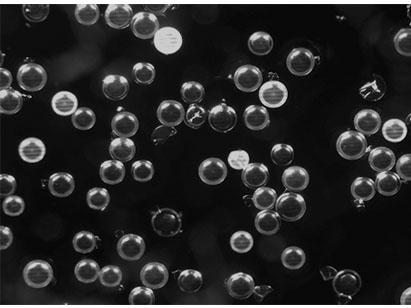Polypeptide targeting novel coronavirus COVID-19 and application of polypeptide
A technology for COVID-19 and coronavirus, applied in the field of peptides targeting the new coronavirus COVID-19, can solve the difficult problems of effective treatment of coronavirus, and achieve the effect of enriching sequence diversity, ensuring efficiency and small molecular weight
- Summary
- Abstract
- Description
- Claims
- Application Information
AI Technical Summary
Problems solved by technology
Method used
Image
Examples
Embodiment 1
[0091] Example 1 Biotin or FITC labeling of S protein
[0092] In this example, the S protein (SEQ ID NO: 29) is first labeled with biotin or FITC, and the steps are as follows:
[0093] 0.15 mol / L NaCl solution and 0.15 mol / L NaHCO at pH=9.0 3 -Na2 CO 3 The buffer solution was mixed at a molar ratio of 9:1, and protein S was added to the mixture for protein dissolution, so that the final concentration of protein S was 10 mg / mL;
[0094] Add biotin or FITC to the S protein solution, place in an ice bath, and magnetically stir overnight in the dark;
[0095] On the second day, the mixed solution was placed in a dialysis bag with a molecular weight cut-off of 200, dialyzed in deionized water for two days, and the water was changed several times;
[0096] Finally, the dialyzed solution was collected and freeze-dried by a freeze dryer to obtain biotin- or FITC-labeled S protein.
Embodiment 2
[0097] Embodiment 2 Establishment of OBOC polypeptide library
[0098] In this example, the OBOC method is used to synthesize a peptide library on resin beads (beads), and the steps are as follows:
[0099] (1) Take 1.8 g of resin beads and put them in the synthesis tube, add a certain amount of DMF to soak the resin for resin swelling, and soak for more than 2 hours;
[0100] (2) Add Fmoc-protected methionine (M) to the synthesis tube, and add a mixture of HOBT (1-hydroxybenzotriazole) and DIC (N,N'-diisopropylcarbodiimide) solution, reacted on a shaking table for more than 2 h; alternately rinsed with methanol and DMF three times, repeatedly blowing up the beads with a straw during the rinse process; then tested the beads in a ninhydrin boiling water bath, and the beads were colorless;
[0101] (3) Add a deprotection agent (20% hexahydropyridine + 80% DMF) for Fmoc deprotection for 10 min, alternately rinse with methanol and DMF three times, and repeatedly blow up the beads...
Embodiment 3
[0108] Example 3 Screening of polypeptides targeting S protein
[0109] The FITC-labeled S protein and the peptide library were incubated in PBS buffer for 2 hours, the luminescence was observed under a fluorescence microscope (excitation wavelength 405 nm), and the observed peptide resins with obvious green fluorescence were selected.
[0110] like figure 1 Shown is the fluorescent microscope picture of FITC-labeled S protein interacting with OBOC polypeptide library. The beads bound to S protein can be observed with green fluorescence, and the peptides that can bind to S protein are selected according to the fluorescence.
[0111] The selected polypeptide resin was washed several times with ultrapure water and dried, using 30% CNBr 3 The ethanol solution was lysed overnight, the supernatant was obtained by centrifugation, and the peptide sequencing was carried out after desalting treatment.
[0112] Exemplarily, Figure 2(A), Figure 2(B), Figure 2(C) and Figure 2(D) are the...
PUM
 Login to View More
Login to View More Abstract
Description
Claims
Application Information
 Login to View More
Login to View More - R&D
- Intellectual Property
- Life Sciences
- Materials
- Tech Scout
- Unparalleled Data Quality
- Higher Quality Content
- 60% Fewer Hallucinations
Browse by: Latest US Patents, China's latest patents, Technical Efficacy Thesaurus, Application Domain, Technology Topic, Popular Technical Reports.
© 2025 PatSnap. All rights reserved.Legal|Privacy policy|Modern Slavery Act Transparency Statement|Sitemap|About US| Contact US: help@patsnap.com



